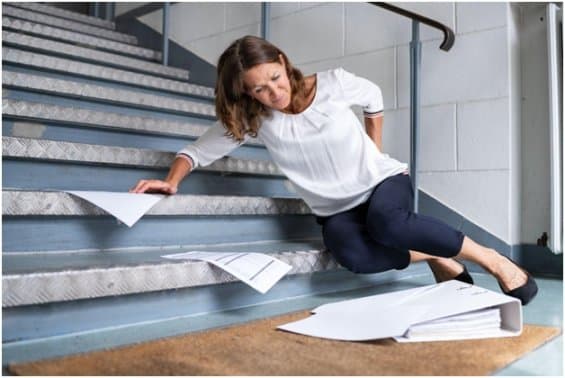Slip and fall accidents are common occurrences that can result in various injuries. These types of incidents can take place anywhere, including at home, in public places, or at work. Due to their unpredictable nature, it’s crucial to understand the common injuries associated with slip and fall accidents, so individuals can take necessary precautions to protect themselves and seek appropriate medical care if an accident occurs.

Types of Slip and Fall Injuries
Slip and fall accidents can result in various types of injuries that range in severity.
Soft Tissue Injuries
Soft tissue injuries are often difficult to detect immediately after an accident, as they can take time to manifest. These types of injuries include:
- Sprains: Ligament injuries, often occurring in the ankle, knee, or wrist.
- Strains: Muscle or tendon injuries, commonly occurring in the back or neck.
- Contusions: Bruises caused by the impact of an object on soft tissue, resulting in discolored skin and soreness.
Head Injuries
Head injuries from slip and fall accidents can range from mild concussions to severe traumatic brain injuries (TBI). Signs of a head injury include:
- Headache
- Dizziness
- Confusion
- Memory loss
- Nausea
Spinal and Back Injuries
Injuries to the spine and back can have potentially severe repercussions, impacting the victim’s mobility and overall quality of life. Common spinal and back injuries include:
- Herniated Discs: Occurs when a spinal disc’s soft center is forced through a weakened wall, causing pain and discomfort.
- Spinal Cord Injuries: Damage to the spinal cord, leading to partial or complete loss of mobility and sensation below the injury site.
Bone Fractures
Slip and fall accidents can result in various types of bone fractures, including:
- Simple Fractures: A break with minimal displacement and no penetration of the skin.
- Compound Fractures: A break with displacement and penetration of the skin.
- Comminuted Fractures: A break with multiple fragments.
Cuts and Abrasions
Cuts and abrasions from slip and fall accidents can vary in size, depth, and severity. These injuries include:
- Lacerations: Deep cuts that may require stitches and can leave scars.
- Abrasions: Superficial skin injuries, such as scrapes or scratches.
Factors Influencing Injury Severity
Several factors can influence the severity of injuries resulting from slip and fall accidents. These factors include the environment, the individual’s physical condition, and the nature of the fall itself. By understanding these factors, preventive measures can be taken to minimize potential injuries in case of a slip and fall accident.
- Environment:
The surface on which the fall occurs plays a crucial role in determining the severity of the injury. Falls on hard or uneven surfaces can lead to more severe injuries, as they increase the likelihood of direct and forceful contact between the body and the ground. Moreover, the presence of sharp objects in the vicinity of the fall increases the risk of puncture wounds and lacerations. - Individual’s Physical Condition:
A person’s physical condition, age, and overall health can affect the outcomes of a slip and fall accident. For instance, older adults tend to have more fragile bones and weakened muscles, making them more susceptible to fractures and muscle strains. Similarly, individuals with pre-existing medical conditions may be at higher risk for complications due to weakened immunity or other factors associated with their conditions. - Nature of the Fall:
The way a person falls also plays a role in determining the severity of the injuries sustained. Key factors include:
- Direction of the fall: Falls on one’s back or side are typically less severe compared to falls where the person lands on their face or head.
- Height of the fall: Falls from greater heights increase the risk of severe injuries due to the elevated intensity of the impact.
- Force of the fall: The force with which a person falls can determine the potential trauma to internal organs, muscles, and bones. A more forceful fall may produce more severe injuries.
- Ability to brace for impact: Individuals who are able to break their fall using their arms or legs may experience less severe injuries, as these limbs can absorb some of the impact.
If you feel like you fell and it was the result of someone else’s negligence, it’s possible a slip and fall lawsuit is your best course of action moving forward.

